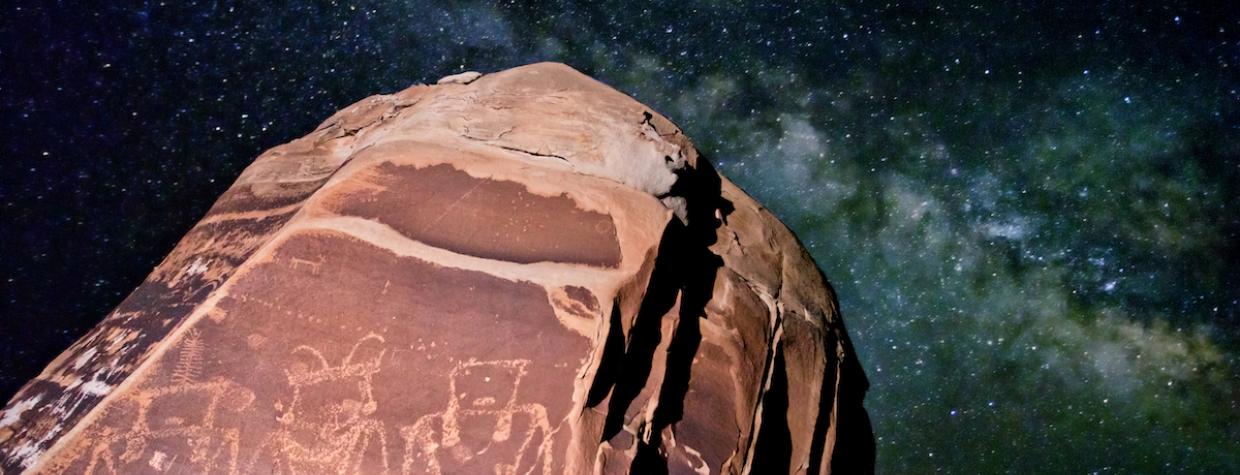Back in 2015, we told you about Jonathan Bailey, whose book Rock Art: A Vision of a Vanishing Cultural Landscape aims to help protect rock art sites around the American Southwest. Plenty has changed since the book's first printing, so now, Bailey is releasing an updated version with new photos and essays by notable contributors. The new edition is available for pre-order now and will be released later this year. Via email, we spoke with Bailey about why the extensive update was needed.
What was the response to the first edition of the book? Were people enthusiastic about your message and your goal of preserving these sites?
The response to the book specifically was overwhelmingly positive, but I think, more broadly speaking, preserving cultural resources is a deeply controversial and political topic. We have witnessed in recent years, particularly with the Bears Ears and Grand Staircase-Escalante national monuments, how quickly conversations about preservation and the inherent rights of tribes can become dangerously divisive.
Tell us about some of those conversations and why you felt they made it necessary to revise the book so extensively.
As the first book was being submitted, Bears Ears was just beginning to gain traction. It had not been designated, and the [federal] monument review that resulted in the reduction of the Bears Ears and Escalante national monuments had not occurred. It is not the case that I set out to write about these designations in particular, especially considering that the lawsuits and legislation are far from settled. That being said, there were a lot of larger thoughts and issues raised in the process. Why are national monuments needed? Who does the past belong to? Why are existing protections insufficient? Why does the past matter in the present? The only way I felt I could address these questions was through an extensive revision of the book.
On another level, the deadline of the previous iteration was occurring at roughly the same time as an archaeological conference, preventing several prospective contributors from being a part of the project. Coincidentally, this resulted in a book that had only a single female contributor, and that definitely needed to change. In the new book, six of the nine new contributors are female.
How much of the book is new?
In many ways, it is almost an entirely new book. Aside from the essays from returning contributors, almost every word has been rewritten — including the captions. We also have many new contributors: Alisha Anderson, Lyle Balenquah, R.E. Burrillo, Kelley Hays-Gilpin, Regina Lopez-Whiteskunk, Connie Massingale, Aaron O'Brien, Geri Schrab and Laurie Webster. This is, of course, in addition to the returning essayists: Lawrence Baca, Greg Child, Andrew Gulliford, James D. Keyser, William Lipe, Lawrence Loendorf, Lorran and Charlotte Meares, Scott Thybony and Paul Tosa.
Also, if you look closely at the cover, you may notice that the book is now landscape-oriented. This allows us to take full advantage of the page and provide many new photographs.
What is the best thing members of the public can do to protect these sites and ensure they survive for future generations to enjoy?
The best thing the general public can do to protect these sites is vote. Beyond that, there are a lot of wonderful organizations that can guide people to more thorough resources. This includes Archaeology Southwest, the Grand Canyon Trust, Utah Diné Bikéyah, the Utah Rock Art Research Association, Southern Utah Wilderness Alliance, the Bears Ears Inter-Tribal Coalition and Friends of Cedar Mesa, to name a few.
Other than Amazon, where else can people get the book or learn more about it?
We are trying to actively encourage people to purchase this book from their independently-owned, local book stores. If you are located in a place where this is not an option, you can also purchase the book directly from Indiebound. You can enter your ZIP code to find a local store or get the book directly at this link.
I can confirm that other books and photographic projects are in active development. I will also be presenting at various bookstores and institutions after the book is released — perhaps with a few surprises along the way. People can follow me on social media for upcoming news on these events.

